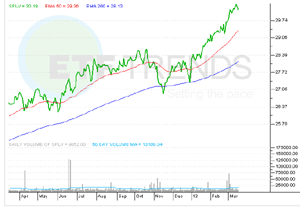Investors are clamoring to reduce their downside risk with low-volatility ETFs, and the industry is responding with plenty of new choices, says John Spence of ETF Trends.
PowerShares S&P 500 Low Volatility Portfolio (SPLV) has hauled in nearly $8 million of inflows a day, every day, since the ETF launched in May 2011.
The popularity of low-volatility funds highlights the anxiety in the wake of the financial crisis. Investors remain skittish despite the Dow Jones Industrial Average rising to a new all-time high.
SPLV was the first low-volatility ETF, and has gathered assets of $4 billion in less than two years. “As the flagship low-volatility ETF on the market, SPLV has averaged over $7.6 million in inflows per day since its inception,” notes Ben Fulton, Invesco PowerShares managing director of global ETFs.
SPLV holds the 100 stocks from the S&P 500 with the lowest realized volatility over the past year. Volatility measures the tendency of a stock to fluctuate in price. Also, the ETF gives a greater weighting to stocks with lower volatility. Most ETF benchmarks weight companies by their size or market cap.
“Investors have been allocating low-volatility ETF strategies as core portfolio holdings,” said John Feyerer, head of product strategy and research at Invesco PowerShares. “PowerShares low-volatility ETFs are based on an index methodology that is easy to understand and are an effective way for investors to add or maintain equity exposures, while attempting to mitigate overall portfolio risk. We believe the PowerShares suite of low-volatility ETFs represent an attractive alternative to cap weighted strategies.”
Other low-volatility ETFs include iShares MSCI USA Minimum Volatility ETF (USMV), PowerShares S&P International Developed Low Volatility (IDLV), and iShares MSCI Emerging Markets Minimum Volatility (EEMV).
“The Dow is at record levels, the S&P 500 is approaching a new record, and market professionals are showing a high level of optimism, so it might come as something of a surprise to see that low-volatility ETFs have been one of the hottest corners of the fund landscape in recent months. The concept behind these funds certainly makes sense, particularly for investors who wish to stay exposed to the markets but have concerns about short-term downside risks,” says S&P Capital IQ.
Low-volatility ETFs have experienced unusually strong demand, and are performing quite well so far in 2013. Citing BlackRock data, S&P says in the first two months of 2013, the 34 low-volatility exchange traded products gathered on average $926 million in new assets each month, more than double what was added to them a year earlier.
State Street (STT) recently launched its first low-volatility ETFs: SPDR Russell 2000 Low Volatility ETF (SMLV) and SPDR Russell 1000 Low Volatility ETF (LGLV).
S&P notes that low-volatility ETFs can vary in their portfolio construction, so investors should do some research before choosing a fund.
“We think investors wanting to stay invested in the market but protect some of their downside should look at one of these low-volatility products, as the benchmarks they seek to replicate have strong records in flat and down markets, while only lagging somewhat in recent up markets,” said Todd Rosenbluth, S&P Capital IQ Director of ETF Research.
For the trailing 12 months, SPLV is up 17.6%, compared with a total return of 13.1% for the S&P 500, according to Morningstar.
Read more from ETF Trends here...
Related Articles:
Low-Volatility ETFs: The New Black




















